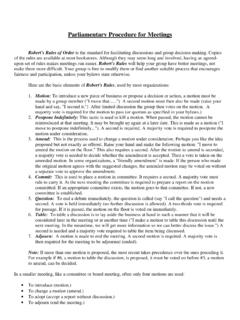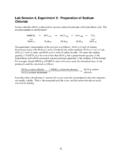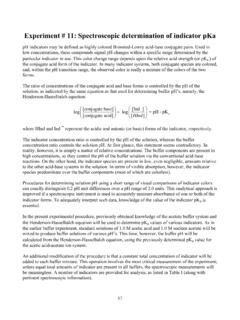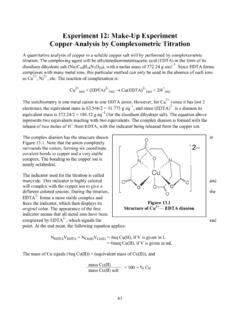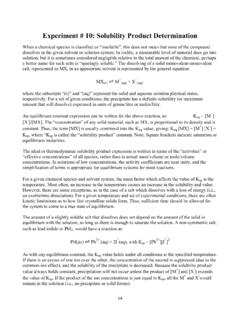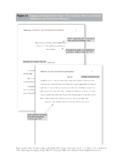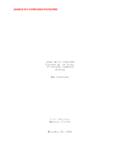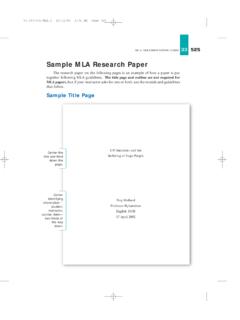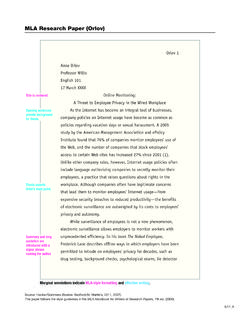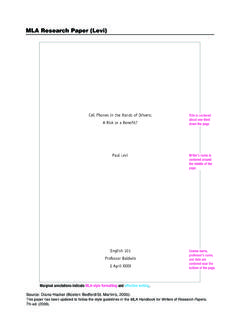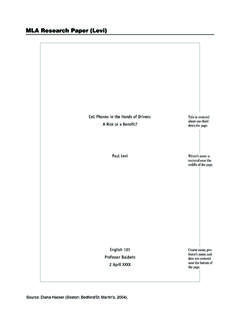Transcription of MLA Style: An Introduction
1 mla style : AN Introduction Presented by the ULM Library Reference Department Session Overview What is mla style ? General Guidelines Quotations/Paraphrasing In-text Citations Works Cited Resources Q & A Time What Is mla style ? a set of rules intended to encourage and maintain clear, concise writing provides guidelines for formatting papers used to create citations for resources What Is mla style ? Primarily used by the liberal arts and humanities, like Art and English, but sometimes used in disciplines like: Communication Studies Foreign languages and literatures Cultural Studies Media Studies What Is mla style , Continued Like any style format, it is intended to establish and maintain consistency and quality in research It also supports scholarly communication by facilitating documentation, , it demonstrates a common way of citing sources so other scholars can consult the resources you used So You Will Use It Format your paper , Margins Spacing Font selection and size Headers/footers Guide the style of your paper , Quotations In-text citations Voice General Guidelines 1-inch margins on all sides Double-spaced 12 point font Times New Roman or a similar font , something legible and professional Examples.
2 Arial, Century Gothic, or Garamond General Guidelines Page headers Includes page numbers and author s name May be omitted from first page Only one space following ending punctuation of sentences Indent first sentence of paragraphs inch from margin MLA recommends simply using the Tab key (versus spacing over manually) Use an active voice whenever possible Guidelines: First Page MLA papers don t typically need cover pages so unless your professor asks for one, it s not necessary to create one MLA papers do need a heading in which you list your name, your professor s name, the class, and the date this is typically double-spaced Guidelines: First Page Guidelines: First Page After the heading, double space down and center the title of your paper The title of your paper should not be in quotation marks, underlined, italicized, or in all capital letters Titles within your title should have quotation marks or italics as needed Guidelines: First Page Guidelines: First Page Examples of titles within titles: The Function of Time in Woolf s To the Lighthouse Sexuality in Faulkner s A Rose for Emily Race and Race Relations in Baraka s Dutchman As kingfishers catch fire : the Poetry of Gerard Manley Hopkins Quotations/Paraphrasing When you re writing a research paper , you re going to have to work other people s research into your own, in order to.
3 Demonstrate the validity of your point of view Inform your audience of what research has been done on the topic Show your audience how your point of view fits into what s been done Quotations/Paraphrasing There are two ways of incorporating information into your paper quoting and paraphrasing MLA has guidelines for how to use quotations and paraphrasing in your writing It s important to understand how these two methods differ Quotations Quotations are straight from the horse s mouth they are the actual words taken from the text, word for word, as they appear in the text itself Quotations can be high impact the words of an expert that support your argument carry a lot of weight Quotations & Quoting But including too many quotations is lazy; you re letting the research do all of the work Sometimes too many quotations looks like plagiarism you re using someone else s ideas as your arguments, rather than as support *You* are supposed to be doing the work; quotations are just tools with which to do the work Quotations & Quoting There are two ways to quote Way #1: direct quotations - include the author s or authors names in the actual text of the sentence: Zimbardo notes that children are totally insensitive to their parents shyness (62).
4 Author s name in the sentence Quotations & Quoting Direction quotations do not allow for change a direct quotation is, word for word, identical to the way it appears in the original text The original text MUST HAVE QUOTATION MARKS around it Zimbardo notes that children are totally insensitive to their parents shyness (62). The quotation marks show where the author s words begin and end, distinguishing them from YOUR writing. Indirect Quotations Way #2: indirect quotations - DO NOT include the author s or authors names in the sentence But you still have to use quotation marks, and you can t make changes to the text Some researchers note that "children are totally insensitive to their parents' shyness" (Zimbardo 62). Not the author s name So it s got to be here Paraphrasing A second way you can incorporate information into your writing is to paraphrase Paraphrasing is the act of taking information from a text and either Summarizing it taking a whole paragraph s worth of information and boiling it down to a few sentences, or Rewording it - demonstrating your understanding of the information by putting it into your own words, in such a way that is significantly different from the original text Paraphrasing.
5 Summary The paragraph you re about to see is very long, too long to quote effectively One of your options is to summarize the paragraph in your own words, reducing and simplifying Remember, though, you ll still have to do an in-text citation (more on that in a minute) Summaries do not require quotation marks Paraphrasing: Summary ORIGINAL TEXT TOO LONG TO QUOTE Children are totally insensitive to their parents' shyness; it is the rare child who labels a parent shy [..] This is understandable, since parents are in positions of control and authority in their homes and may not reveal their shy side to their children. Also, since shyness is viewed as undesirable by many children, it may be threatening to think of parents in these terms. At this young age, the parent is still idealized as all-knowing and all-powerful - - not dumb, ugly, or weak.
6 Zimbardo, Philip G. Shyness: What It Is, What to Do About It. Cambridge, Mass.: Perseus Books, 1977. Print. SUMMARY OF ORIGINAL TEXT EASIER TO USE Because parents are authority figures in the home, children are not immediately aware of their parents shyness; it may be too scary for the children to think of their parents in negative terms. Paraphrasing: Rewording If you aren t concerned with the length of a section, or you feel you can t boil the information down without losing something important, you have the option of putting the information in your own words Make sure the info really is in your own words if it s too close to the original text, it could be considered plagiarism Paraphrasing: Rewording The result of paraphrasing a paragraph may produce a paragraph of equal length, and that s okay What s important is that the information is actually in your own words and That you give credit where credit is due Let s take a look at an example of rewording paraphrasing, shall we?
7 Paraphrasing: Rewording We ll start with the original text look at it closely Then you ll see a paraphrasing of the text the ideas are retained (that s a key element of paraphrasing), but notice how different the wording is The wording HAS to be significantly different, or it looks like plagiarism The more different the wording is, the more you demonstrate how well you understand the info and are able to relay it to the audience Paraphrasing: Rewording ORIGINAL TEXT, AS IS Children are totally insensitive to their parents' shyness; it is the rare child who labels a parent shy [..] This is understandable, since parents are in positions of control and authority in their homes and may not reveal their shy side to their children. Also, since shyness is viewed as undesirable by many children, it may be threatening to think of parents in these terms.
8 At this young age, the parent is still idealized as all-knowing and all-powerful - - not dumb, ugly, or weak. Zimbardo, Philip G. Shyness: What It Is, What to Do About It. Cambridge, Mass.: Perseus Books, 1977. Print. REWORDED/PARAPHRASE A parent s shyness is not often perceived by a child, and rarely would a child describe a parent as being shy. Because parents are authority figures in the home, that shyness may not manifest, nor may the parent behave bashfully in front of the child. Moreover, shyness is often valued in a negative fashion by children, so to think of a parent in this fashion can be unsettling to the child. The child idolizes the parent at this stage of development. Quoting vs. Paraphrasing: When? Both of these methods of using resources in your writing have many benefits so how do you decide when to use which?
9 Remember: quoting is usually high impact it s good for emphasis, when you think taking the words out of the horse s mouth is the best means of persuasion Quoting is like a punch: your opponent CANNOT ignore it! Quoting vs. Paraphrasing: When? Paraphrasing is better for condensing a lot of information into a more manageable amount (like we saw in the summary example) It s also very useful when the information is very technical or the author s style is very dry and inaccessible you can make the info more easy to consume for your audience You can also combine authors ideas that are similar into one passage through paraphrasing smoothie Paraphrasing: More on Combining Ideas Let s say you have two authors who say similar things on a topic. Zimbardo writes: Children are totally insensitive to their parents' shyness.
10 Smith writes: Children are usually unaware when their parents are shy. Paraphrasing: More on Combining Ideas These two passages of information can be blended together ( smoothie) to keep your information concise and to prevent unnecessary repetition. So, a paraphrase of their information blended together would look like this: Some researchers note that children are often ignorant with regard to their parents shyness (Zimbardo 62; Smith 45). Incorporating Info into Your Writing It s NOT recommended that you just put quotations in your writing without some kind of preamble or Introduction or explanation A good rule of thumb is that every sentence in your writing should contain something you wrote, no matter what Transitions are important, particularly between your writing and thoughts, and the quotations Incorporating Info into Your Writing That Zimbardo quotation we ve looked is a good example of an incorporated quotation, both in the direct and indirect style.

